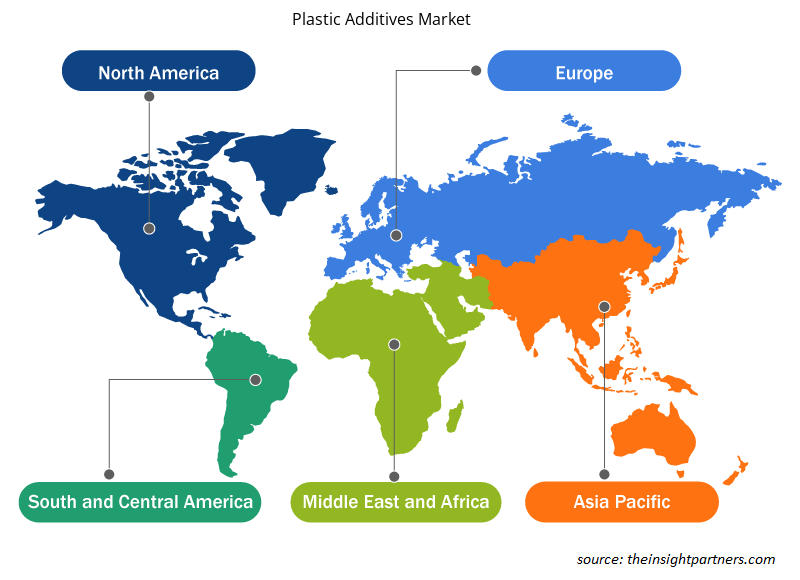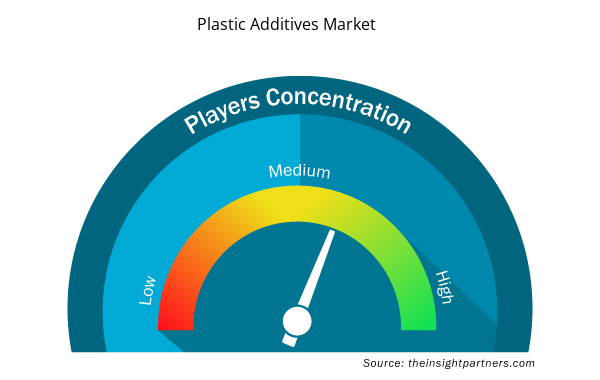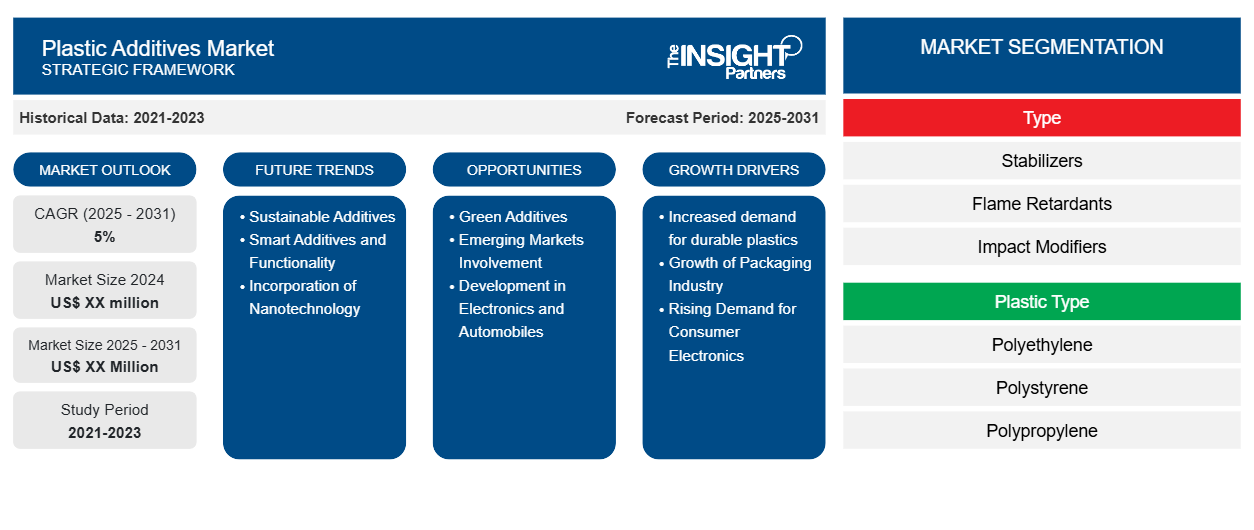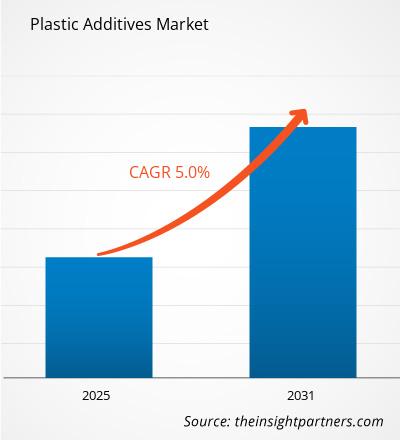Si prevede che il mercato degli additivi per plastica registrerà un CAGR del 5% dal 2023 al 2031, con una dimensione di mercato in espansione da XX milioni di dollari nel 2023 a XX milioni di dollari entro il 2031.CAGR of 5% from 2023 to 2031, with a market size expanding from US$ XX million in 2023 to US$ XX Million by 2031.
Il mercato degli additivi per la plastica comprende l'analisi per tipo (stabilizzanti, ritardanti di fiamma, modificatori di impatto, plastificanti e altri), tipo di plastica (polietilene (PE), polistirene (PS), polipropilene (PP), poliammidi (PA), polietilene, tereftalato (PET), cloruro di polivinile (PVC) e altri), applicazione (imballaggio, beni di consumo, edilizia, automotive e altri) e geografia (Nord America, Europa, Asia Pacifico, Medio Oriente e Africa e Sud e Centro America). Il mercato degli additivi per la plastica è guidato da molti fattori, tra cui la crescente domanda di materie plastiche, la loro funzionalità migliorata, la crescita specifica del settore e i progressi tecnologici. Le continue innovazioni nello sviluppo di additivi per la plastica nuovi e migliorati creano opportunità entusiasmanti.Plasticizers, and Others), Plastic Type (Polyethylene (PE), Polystyrene (PS), Polypropylene (PP), Polyamides (PA), Polyethylene, Terephthalate (PET), Polyvinyl Chloride (PVC), and Others), and Application (Packaging, Consumer Goods, Construction, Automotive, and Others), and Geography (North America, Europe, Asia Pacific, Middle East and Africa, and South and Central America). The plastic additives market is driven by many factors, including the increasing demand for plastics, their enhanced functionality, specific industry growth, and technological advancements. Continuous innovations in developing new and improved plastic additives create exciting opportunities.
Scopo del rapporto
Il report Plastic Additives Market di The Insight Partners mira a descrivere il panorama attuale e la crescita futura, i principali fattori trainanti, le sfide e le opportunità. Ciò fornirà spunti a vari stakeholder aziendali, come:
- Fornitori/produttori di tecnologia: per comprendere le dinamiche di mercato in evoluzione e conoscere le potenziali opportunità di crescita, consentendo loro di prendere decisioni strategiche informate.
- Investitori: condurre un'analisi completa delle tendenze in merito al tasso di crescita del mercato, alle proiezioni finanziarie del mercato e alle opportunità esistenti lungo la catena del valore.
- Enti di regolamentazione: regolamentano le politiche e le attività di controllo sul mercato allo scopo di ridurre al minimo gli abusi, preservare la fiducia degli investitori e sostenere l'integrità e la stabilità del mercato.
Segmentazione del mercato degli additivi plastici
Tipo
- Stabilizzatori
- Ritardanti di fiamma
- Modificatori di impatto
- Plastificanti
Tipo di plastica
- Polietilene
- Polistirolo
- Polipropilene
- Poliammidi
- Polietilene
- Tereftalato
- Cloruro di polivinile
Applicazione
- Confezione
- Beni di consumo
- Costruzione
- Automobilistico
Geografia
- America del Nord
- Europa
- Asia-Pacifico
- America del Sud e Centro
- Medio Oriente e Africa
Geografia
- America del Nord
- Europa
- Asia-Pacifico
- America del Sud e Centro
- Medio Oriente e Africa
Personalizza questo report in base alle tue esigenze
Riceverai la personalizzazione gratuita di qualsiasi report, comprese parti di questo report, o analisi a livello nazionale, pacchetto dati Excel, oltre a usufruire di grandi offerte e sconti per start-up e università
- Scopri le principali tendenze di mercato in questo rapporto.Questo campione GRATUITO includerà analisi di dati che spaziano dalle tendenze di mercato alle stime e alle previsioni.
Fattori trainanti della crescita del mercato degli additivi plastici
- Aumento della domanda di materie plastiche durevoli: la domanda del mercato degli additivi per materie plastiche è in gran parte stimolata dai crescenti requisiti della plastica, che deve essere resistente, durevole e utilizzata in applicazioni quali l'edilizia, l'industria automobilistica e l'imballaggio, il che ne incrementa ulteriormente l'utilizzo in settori ad alte prestazioni poiché ne migliorano la resistenza, la flessibilità, la resistenza ai raggi UV e la stabilità al calore.
- Crescita del settore degli imballaggi: uno dei principali motori del mercato degli additivi per la plastica è la crescita del settore degli imballaggi dovuta alla crescente domanda di soluzioni di imballaggio innovative e sostenibili. Questi additivi, come plastificanti, stabilizzanti e coloranti, sono molto importanti per produrre materiale di imballaggio di alta qualità con proprietà migliorate come resistenza, trasparenza e riciclabilità.
- Domanda crescente di elettronica di consumo: questo fiorente settore dell'elettronica di consumo fa molto affidamento sulla plastica per realizzare prodotti leggeri, resistenti ed estetici. I ritardanti di fiamma, i modificatori di impatto e gli agenti antistatici sono additivi essenziali per aiutare il settore a rendere i dispositivi elettronici sicuri, performanti ed esteticamente gradevoli, aumentando quindi la domanda di additivi.
Tendenze future del mercato degli additivi plastici
- Additivi sostenibili: nel prossimo futuro, la necessità di additivi più eco-compatibili, non tossici e biodegradabili continuerà ad aumentare. Le aziende hanno già dato vita a prodotti alternativi come plastificanti e stabilizzanti rinnovabili di origine biologica, progettati per scopi equivalenti agli additivi per plastica convenzionali. Queste alternative eco-based derivano dagli sforzi globali per combattere l'inquinamento causato dall'uso della plastica e migliorare la sostenibilità dei prodotti.
- Additivi intelligenti e funzionalità: l'idea di sviluppare plastiche "intelligenti", che incorporino additivi per conferire proprietà quali auto-riparazione, sensibilità alla temperatura o antimicrobiche, promette in futuro di rivoluzionare i settori dell'assistenza sanitaria, degli imballaggi e dell'elettronica. Le nuove funzionalità delle plastiche, di conseguenza, stimoleranno la domanda di additivi speciali con nuove capacità high-tech.
- Incorporazione della nanotecnologia: si prevede che l'incorporazione della nanotecnologia negli additivi plastici migliorerà le prestazioni dei materiali, principalmente migliorandone la resistenza, la conduttività e la resistenza. I nanomateriali possono dare origine a plastiche più leggere, più resistenti e più durevoli, rendendole così molto più attraenti in applicazioni avanzate come l'industria aerospaziale e automobilistica.
Opportunità di mercato degli additivi plastici
- Additivi verdi: oltre a sensibilizzare sulla conservazione della natura e sulle problematiche ambientali a livello globale, una delle principali vie è lo sviluppo di additivi per plastica di terra e la promozione delle loro applicazioni. Dovrebbero prestare attenzione agli additivi biodegradabili, non tossici e a basso contenuto di COV, tutti sviluppati in prodotti di plastica, che dovrebbero soddisfare la crescente domanda di soluzioni sostenibili in questo settore, tra cui un rilascio veramente verde per i produttori.
- Coinvolgimento dei mercati emergenti: l'industrializzazione e l'urbanizzazione nelle aree in via di sviluppo porteranno a una domanda crescente di additivi per la plastica. I settori in rapida crescita in Asia-Pacifico, America Latina e Africa sono l'automotive, il packaging e l'edilizia, che hanno ora potenziali opportunità come mercati emergenti per gli additivi per la plastica.
- Sviluppo in elettronica e automobili: le applicazioni nei segmenti dipartimentale ed elettronico probabilmente prevedono opportunità in multipli per quanto riguarda le dimensioni aziendali nel segmento degli additivi per materie plastiche. Il megatrend di componenti più leggeri, più resistenti e più efficienti in termini di prestazioni aumenterà drasticamente le applicazioni di tali additivi nel miglioramento delle proprietà, nella protezione dalle fiamme, nella resistenza ai raggi UV e nella resistenza agli urti nei settori ad alta tecnologia.
Approfondimenti regionali sul mercato degli additivi plastici
Le tendenze regionali e i fattori che influenzano il mercato degli additivi per la plastica durante il periodo di previsione sono stati ampiamente spiegati dagli analisti di Insight Partners. Questa sezione discute anche i segmenti e la geografia del mercato degli additivi per la plastica in Nord America, Europa, Asia Pacifico, Medio Oriente e Africa e America meridionale e centrale.

- Ottieni i dati specifici regionali per il mercato degli additivi per la plastica
Ambito del rapporto di mercato sugli additivi plastici
| Attributo del report | Dettagli |
|---|---|
| Dimensioni del mercato nel 2023 | XX milioni di dollari USA |
| Dimensioni del mercato entro il 2031 | XX milioni di dollari USA |
| CAGR globale (2023-2031) | 5% |
| Dati storici | 2021-2022 |
| Periodo di previsione | 2024-2031 |
| Segmenti coperti | Per tipo
|
| Regioni e Paesi coperti | America del Nord
|
| Leader di mercato e profili aziendali chiave |
|
Densità degli attori del mercato degli additivi plastici: comprendere il suo impatto sulle dinamiche aziendali
Il mercato degli additivi per la plastica sta crescendo rapidamente, spinto dalla crescente domanda degli utenti finali dovuta a fattori quali l'evoluzione delle preferenze dei consumatori, i progressi tecnologici e una maggiore consapevolezza dei benefici del prodotto. Con l'aumento della domanda, le aziende stanno ampliando le loro offerte, innovando per soddisfare le esigenze dei consumatori e capitalizzando sulle tendenze emergenti, il che alimenta ulteriormente la crescita del mercato.
La densità degli operatori di mercato si riferisce alla distribuzione di aziende o società che operano in un particolare mercato o settore. Indica quanti concorrenti (operatori di mercato) sono presenti in un dato spazio di mercato in relazione alle sue dimensioni o al valore di mercato totale.
Le principali aziende che operano nel mercato degli additivi per la plastica sono:
- Akzo Nobel NV
- Società Albemarle
- Baerlocher GmbH
- BASF SE
- Bayer AG
- Clariante
Disclaimer : le aziende elencate sopra non sono classificate secondo un ordine particolare.

- Ottieni una panoramica dei principali attori del mercato degli additivi per plastica
Punti di forza chiave
- Copertura completa: il rapporto copre in modo completo l'analisi di prodotti, servizi, tipologie e utenti finali del mercato degli additivi per plastica, fornendo una panoramica olistica.
- Analisi degli esperti: il rapporto è compilato sulla base della conoscenza approfondita di esperti e analisti del settore.
- Informazioni aggiornate: il rapporto garantisce la pertinenza aziendale grazie alla copertura di informazioni recenti e tendenze nei dati.
- Opzioni di personalizzazione: questo report può essere personalizzato per soddisfare le esigenze specifiche del cliente e adattarsi in modo appropriato alle strategie aziendali.
Il rapporto di ricerca sul mercato degli additivi per la plastica può, quindi, aiutare a guidare il percorso di decodifica e comprensione dello scenario del settore e delle prospettive di crescita. Sebbene possano esserci alcune preoccupazioni valide, i vantaggi complessivi di questo rapporto tendono a superare gli svantaggi.
- Analisi storica (2 anni), anno base, previsione (7 anni) con CAGR
- Analisi PEST e SWOT
- Valore/volume delle dimensioni del mercato - Globale, regionale, nazionale
- Industria e panorama competitivo
- Set di dati Excel



Report Coverage
Revenue forecast, Company Analysis, Industry landscape, Growth factors, and Trends

Segment Covered
This text is related
to segments covered.

Regional Scope
North America, Europe, Asia Pacific, Middle East & Africa, South & Central America

Country Scope
This text is related
to country scope.
Domande frequenti
Growing demand for sustainable additives is an emerging trend in the market.
The Asia Pacific market is expected to account for the highest CAGR during the forecast period owing to the increasing regulatory pressure in the region.
The stabilizers type segment accounted for the largest market share in 2023
Growing demand for plastics is a key driver in the market
Songwon Industrial Co Ltd, Albemarle Corporation, BASF SE, AkzoNobel, Baerlocher GmbH, Clariant AG, DOW Inc, Bayer AG, Nouryon, and DuPont are some of the key players om the market.
The Plastic Additives Market is estimated to witness a CAGR of 5% from 2023 to 2031
Trends and growth analysis reports related to Chemicals and Materials : READ MORE..
The List of Companies
1. Akzo Nobel N.V.
2. Albemarle Corporation
3. Baerlocher GmbH
4. BASF SE
5. Bayer AG
6. Clariant
7. Emerald Performance Materials
8. Exxon Mobil Corporation
9. LANXESS
10. SONGWON
The Insight Partners performs research in 4 major stages: Data Collection & Secondary Research, Primary Research, Data Analysis and Data Triangulation & Final Review.
- Data Collection and Secondary Research:
As a market research and consulting firm operating from a decade, we have published and advised several client across the globe. First step for any study will start with an assessment of currently available data and insights from existing reports. Further, historical and current market information is collected from Investor Presentations, Annual Reports, SEC Filings, etc., and other information related to company’s performance and market positioning are gathered from Paid Databases (Factiva, Hoovers, and Reuters) and various other publications available in public domain.
Several associations trade associates, technical forums, institutes, societies and organization are accessed to gain technical as well as market related insights through their publications such as research papers, blogs and press releases related to the studies are referred to get cues about the market. Further, white papers, journals, magazines, and other news articles published in last 3 years are scrutinized and analyzed to understand the current market trends.
- Primary Research:
The primarily interview analysis comprise of data obtained from industry participants interview and answers to survey questions gathered by in-house primary team.
For primary research, interviews are conducted with industry experts/CEOs/Marketing Managers/VPs/Subject Matter Experts from both demand and supply side to get a 360-degree view of the market. The primary team conducts several interviews based on the complexity of the markets to understand the various market trends and dynamics which makes research more credible and precise.
A typical research interview fulfils the following functions:
- Provides first-hand information on the market size, market trends, growth trends, competitive landscape, and outlook
- Validates and strengthens in-house secondary research findings
- Develops the analysis team’s expertise and market understanding
Primary research involves email interactions and telephone interviews for each market, category, segment, and sub-segment across geographies. The participants who typically take part in such a process include, but are not limited to:
- Industry participants: VPs, business development managers, market intelligence managers and national sales managers
- Outside experts: Valuation experts, research analysts and key opinion leaders specializing in the electronics and semiconductor industry.
Below is the breakup of our primary respondents by company, designation, and region:

Once we receive the confirmation from primary research sources or primary respondents, we finalize the base year market estimation and forecast the data as per the macroeconomic and microeconomic factors assessed during data collection.
- Data Analysis:
Once data is validated through both secondary as well as primary respondents, we finalize the market estimations by hypothesis formulation and factor analysis at regional and country level.
- Macro-Economic Factor Analysis:
We analyse macroeconomic indicators such the gross domestic product (GDP), increase in the demand for goods and services across industries, technological advancement, regional economic growth, governmental policies, the influence of COVID-19, PEST analysis, and other aspects. This analysis aids in setting benchmarks for various nations/regions and approximating market splits. Additionally, the general trend of the aforementioned components aid in determining the market's development possibilities.
- Country Level Data:
Various factors that are especially aligned to the country are taken into account to determine the market size for a certain area and country, including the presence of vendors, such as headquarters and offices, the country's GDP, demand patterns, and industry growth. To comprehend the market dynamics for the nation, a number of growth variables, inhibitors, application areas, and current market trends are researched. The aforementioned elements aid in determining the country's overall market's growth potential.
- Company Profile:
The “Table of Contents” is formulated by listing and analyzing more than 25 - 30 companies operating in the market ecosystem across geographies. However, we profile only 10 companies as a standard practice in our syndicate reports. These 10 companies comprise leading, emerging, and regional players. Nonetheless, our analysis is not restricted to the 10 listed companies, we also analyze other companies present in the market to develop a holistic view and understand the prevailing trends. The “Company Profiles” section in the report covers key facts, business description, products & services, financial information, SWOT analysis, and key developments. The financial information presented is extracted from the annual reports and official documents of the publicly listed companies. Upon collecting the information for the sections of respective companies, we verify them via various primary sources and then compile the data in respective company profiles. The company level information helps us in deriving the base number as well as in forecasting the market size.
- Developing Base Number:
Aggregation of sales statistics (2020-2022) and macro-economic factor, and other secondary and primary research insights are utilized to arrive at base number and related market shares for 2022. The data gaps are identified in this step and relevant market data is analyzed, collected from paid primary interviews or databases. On finalizing the base year market size, forecasts are developed on the basis of macro-economic, industry and market growth factors and company level analysis.
- Data Triangulation and Final Review:
The market findings and base year market size calculations are validated from supply as well as demand side. Demand side validations are based on macro-economic factor analysis and benchmarks for respective regions and countries. In case of supply side validations, revenues of major companies are estimated (in case not available) based on industry benchmark, approximate number of employees, product portfolio, and primary interviews revenues are gathered. Further revenue from target product/service segment is assessed to avoid overshooting of market statistics. In case of heavy deviations between supply and demand side values, all thes steps are repeated to achieve synchronization.
We follow an iterative model, wherein we share our research findings with Subject Matter Experts (SME’s) and Key Opinion Leaders (KOLs) until consensus view of the market is not formulated – this model negates any drastic deviation in the opinions of experts. Only validated and universally acceptable research findings are quoted in our reports.
We have important check points that we use to validate our research findings – which we call – data triangulation, where we validate the information, we generate from secondary sources with primary interviews and then we re-validate with our internal data bases and Subject matter experts. This comprehensive model enables us to deliver high quality, reliable data in shortest possible time.


 Ottieni un campione gratuito per questo repot
Ottieni un campione gratuito per questo repot